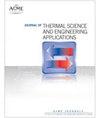柱面前缘模型上液膜冷却的实验研究
IF 1.4
4区 工程技术
Q3 ENGINEERING, MECHANICAL
引用次数: 0
摘要
摘要与传统的气膜冷却相比,液膜冷却所需的冷却剂更少,温度分布更均匀,是一种有效的高温涡轮叶片冷却方法。研究了燃气轮机叶片前缘圆柱模型的射流冷却问题。实验在10万雷诺数的低速风洞中进行。采用压敏涂料测量绝热膜的冷却效果。采用增材制造技术在试验筒上制备了多孔结构,用于射流冷却。冷却喷射采用单角和复合角两种方式。在固定密度比为1的情况下,研究了顺流和展向孔间距、湍流强度(1%和8.7%)和吹气比(0.075、0.15、0.3和0.6)对吹气效果的影响。积液孔直径为0.1 cm,孔径比为2或4。与传统的膜冷却相比,射流冷却具有更高的冷却效率和更好的冷却剂覆盖率。增大流向间距明显降低了单角度设计的冷却效果,因为膜的上升;因此,复合角度设计获得了更高的效率。单角孔对主流湍流强度的变化更为敏感;湍流强度的增加促进了冷却剂与主流的混合。此外,在高吹气比下,射流冷却更能抵抗冷却剂的上升。本文章由计算机程序翻译,如有差异,请以英文原文为准。
Experimental Investigation of Effusion Film Cooling on a Cylindrical Leading Edge Model
Abstract Effusion film cooling is effective for cooling high-temperature turbine blades because it requires less coolant and produces a more uniform temperature distribution than conventional film cooling. Effusion cooling for a cylindrical model representing the leading edge of a gas turbine blade was investigated. The experiment was performed in a low-speed wind tunnel at a Reynolds number of 100,000. Pressure-sensitive paint was used to measure the adiabatic film cooling effectiveness. Additive manufacturing was used to fabricate a porous structure on the test cylinder for effusion cooling. Both simple and compound angles were used for cooling injection. The effects of streamwise and spanwise hole spacings, turbulence intensities (1% and 8.7%), and blowing ratios (0.075, 0.15, 0.3, and 0.6) were studied at a fixed density ratio of 1. The effusion hole diameter was 0.1 cm, and the spanwise hole pitch-to-diameter ratio was either 2 or 4. Compared with conventional film cooing, effusion cooling achieved a higher cooling effectiveness and produced a better coolant coverage. Increasing the streamwise spacing noticeably reduced the cooling effectiveness for the simple-angle design due to film lift-off; the compound-angle designs thus achieved higher effectiveness. The simple-angle holes were more sensitive to changes in the mainstream turbulence intensity; increases in the turbulence intensity promoted the mixing of the coolant with the mainstream. Moreover, effusion cooling was more resistant to coolant lift-off at high blowing ratios.
求助全文
通过发布文献求助,成功后即可免费获取论文全文。
去求助
来源期刊

Journal of Thermal Science and Engineering Applications
THERMODYNAMICSENGINEERING, MECHANICAL -ENGINEERING, MECHANICAL
CiteScore
3.60
自引率
9.50%
发文量
120
期刊介绍:
Applications in: Aerospace systems; Gas turbines; Biotechnology; Defense systems; Electronic and photonic equipment; Energy systems; Manufacturing; Refrigeration and air conditioning; Homeland security systems; Micro- and nanoscale devices; Petrochemical processing; Medical systems; Energy efficiency; Sustainability; Solar systems; Combustion systems
 求助内容:
求助内容: 应助结果提醒方式:
应助结果提醒方式:


